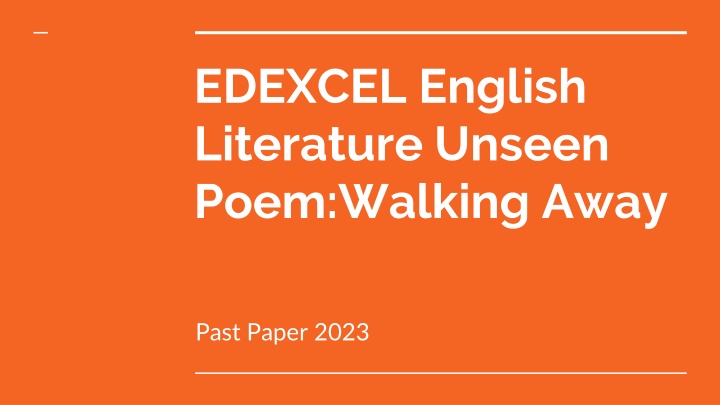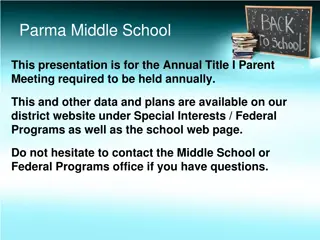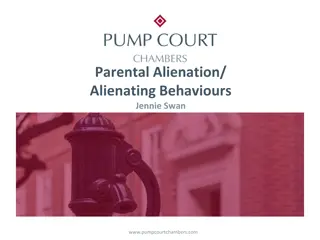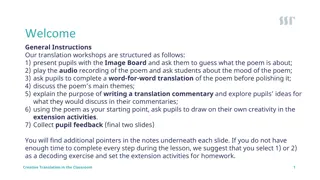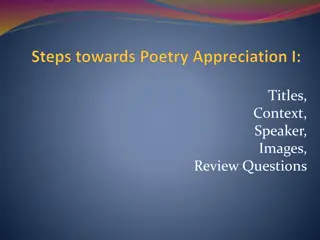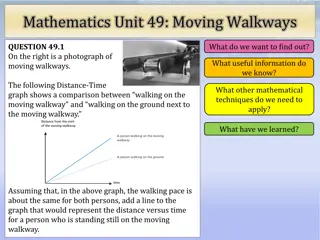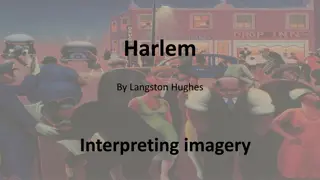Parental Reflections in 'Walking Away' Poem
The poem 'Walking Away' by Cecil Day Lewis delves into a parent's emotional journey as they witness their child growing up and leaving. Through vivid imagery and poignant language, the poem captures feelings of nostalgia, reluctance, and acceptance. The parent grapples with the bittersweet experience of watching their child evolve and ultimately depart, symbolizing the essence of selfhood and love through separation
Uploaded on Feb 21, 2025 | 1 Views
Download Presentation

Please find below an Image/Link to download the presentation.
The content on the website is provided AS IS for your information and personal use only. It may not be sold, licensed, or shared on other websites without obtaining consent from the author.If you encounter any issues during the download, it is possible that the publisher has removed the file from their server.
You are allowed to download the files provided on this website for personal or commercial use, subject to the condition that they are used lawfully. All files are the property of their respective owners.
The content on the website is provided AS IS for your information and personal use only. It may not be sold, licensed, or shared on other websites without obtaining consent from the author.
E N D
Presentation Transcript
EDEXCEL English Literature Unseen Poem:Walking Away Past Paper 2023
Attention: Examiners comments on several occasions: please do not summarise or retell the story Show you know the devices that create specific feeling/context the exam question asks Link your analysis together, so that it is coherent and related to the question
Walking Away Cecil Day Lewis (published 1962) It is eighteen years ago, almost to the day A sunny day with the leaves just turning, The touch-lines new-ruled since I watched you play Your first game of football, then, like a satellite Wrenched from its orbit, go drifting away 5 Behind a scatter of boys. I can see You walking away from me towards the school With the pathos* of a half-fledged thing set free Into a wilderness, the gait* of one
That hesitant figure, eddying* away Like a winged seed loosened from its parent stem, Has something I never quite grasp to convey About nature s give-and-take the small, the scorching Ordeals which fire one s irresolute clay*. I have had worse partings, but none that so Gnaws at my mind still. Perhaps it is roughly Saying what God alone could perfectly show How selfhood begins with a walking away, And love is proved in the letting go. *pathos sadness *gait way of walking *eddying moving in a circle *fire one s irresolute clay form a personality
Explore how the writer presents the parents thoughts about the child in this poem. In your answer, you should consider the writer s: descriptive skills choice of language Support your answer with examples from the poem.
Example of Introduction Intro: Cecil Day Lewis wrote "Walking Away" to convey a parent's memory of their child's childhood and the nostalgic and reluctant feelings, tinged with sadness, knowing their child is about to leave them as they grow up. This poem has four stanzas, each consisting of four lines. The stanzas reflect the stages of the parent's emotions: cheerful in the first stanza, worried in the second stanza, melancholy in the third stanza, and coming to terms with their child's departure due to adulthood in the fourth stanza.
Example of Body 1 The poem describes the parent s nostalgic feelings. It is written in a simple rhyming pattern: day, play, way. .It recalls their child s first football game in with the leaves just turning, which is autumn. The vivid imagery helps us understand how small the child was and how he was still a new football player. There is also an enjambment: /Since I watched you play/ Your first game of football. This emphasises the rising of the parent s emotions. Overall, this evokes a joyful mood when they are thinking of the old days.
Example of Body 2 Moreover, the poet describe the child moving around unorderly, just like a satellite . This simile shows us the movement of boys dispersing across the field. They did not have a strategy for playing football yet. The first stanza shows us that the child is small and inexperienced, yet the parent was there to watch him closely and could remember the scene clearly. This evokes a strong emotion of attachment. Therefore, the poet has effectively used structural and language devices to illustrate the attachment and each phase of the parent s developing feelings towards their child s parting.
Example of Body 3 The poem also expresses the parent s concern for their child. They describe their child as half-fledged. This metaphor likens the child to a young bird that is not fully grown, with the phrase set free implying the freedom of this young bird (the child) to roam around, which is not properly realised, reflected by the irony in find no path where the path should be. This implies the parent s worried feeling that the child could be lost and cannot find a way out. Moreover, the use of plosive/repetition path path highlights the strong emotion of apprehension. Again, Cecil Day Lewis creates an intense feeling of bond and closeness as well as apprehension of the parent for their young child
Example of Body 4 In the last part of the poem, Cecil Day Lewis uses the powerful words Gnaws at my mind still. to emphasise the pain in the parent s heart for letting their child go. Additionally, throughout the poem, the word away is used four times. The repetition implies the anxiety of the parent when they have to accept this departure. The last phrase of the poem and love is proved in the letting go. is a clich that reminds them to come to terms emotionally with their child's leaving. The effectively uses devices to convey that the parent learn to accept the reality of children growing up and leaving home, evoking the feeling of elation and acceptment
Example of Conclusion Through various literary and structural devices, the poet has successfully presented the development of the parent's thoughts from nostalgia for the good old days to apprehension as the child grows up with uncertainty, culminating in their acceptance that once the child is an adult, they need to accept their departure.
